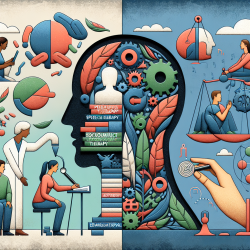In the realm of speech therapy and language education, understanding the diverse backgrounds and challenges faced by individuals is crucial for providing effective support and intervention. The research article "Language and Disadvantage 2nd edition" offers profound insights into the sociolinguistic challenges encountered by disadvantaged speakers and presents a compelling argument for a more inclusive approach to language learning and therapy. This blog post aims to explore the outcomes of this research and how practitioners can implement these findings to improve their skills and encourage further research in this vital area.
At the heart of the discussion is the distinction between viewing nonstandard language use as a deficiency versus recognizing it as simply different. This perspective shift is critical for speech-language pathologists, educators, and therapists who work with diverse populations. The research underscores the importance of acknowledging the social attitudes and biases that contribute to the disadvantages faced by individuals who use nonstandard English. By understanding these challenges, practitioners can develop more effective strategies that respect the linguistic and cultural backgrounds of their clients.
One of the key takeaways from the research is the need for a more nuanced approach to language therapy and education. Traditional methods that focus solely on correcting nonstandard speech can inadvertently reinforce societal biases and undermine the self-esteem of individuals who are already at a disadvantage. Instead, the research advocates for a model of intervention that includes:
- Valuing linguistic diversity and recognizing the strengths of nonstandard language varieties.
- Integrating personal construct therapy approaches, as discussed in the section on stuttering treatment, to address the personal growth and development of both clients and clinicians.
- Offering support that enables individuals to navigate between different language varieties, providing them with the tools to choose the most appropriate form of speech for different contexts.
- Encouraging exposure to standard speech in educational settings while respecting and valuing the individual's native dialect or language.
This approach not only promotes linguistic flexibility but also supports the overall well-being of the individual. It recognizes that language is deeply intertwined with identity and social belonging, and that therapy and education should empower individuals rather than constrain them.
Furthermore, the research highlights the importance of understanding the sociolinguistic context in which language disorders occur. Speech-language pathologists and therapists are encouraged to familiarize themselves with the cultural and linguistic norms of their clients' communities. This knowledge is essential for making informed intervention decisions and for advocating for the needs of disadvantaged speakers within the broader educational and healthcare systems.
Implementing the outcomes of this research requires a commitment to ongoing learning and professional development. Practitioners are encouraged to delve deeper into the sociolinguistic aspects of language disadvantage and to explore personal construct therapy and other innovative approaches to stuttering treatment. Engaging with this research can inspire new strategies for supporting individuals who face language-related challenges, ultimately contributing to a more equitable and inclusive practice.
In conclusion, the "Language and Disadvantage 2nd edition" research article offers invaluable insights for practitioners seeking to enhance their therapeutic approaches. By embracing a sociolinguistic perspective and recognizing the value of linguistic diversity, speech-language pathologists, therapists, and educators can better support the unique needs of disadvantaged speakers. This research underscores the importance of adopting a holistic and inclusive approach to language therapy and education, one that fosters personal growth, social inclusion, and linguistic empowerment.
To read the original research paper, please follow this link: Language and Disadvantage 2nd edition.










